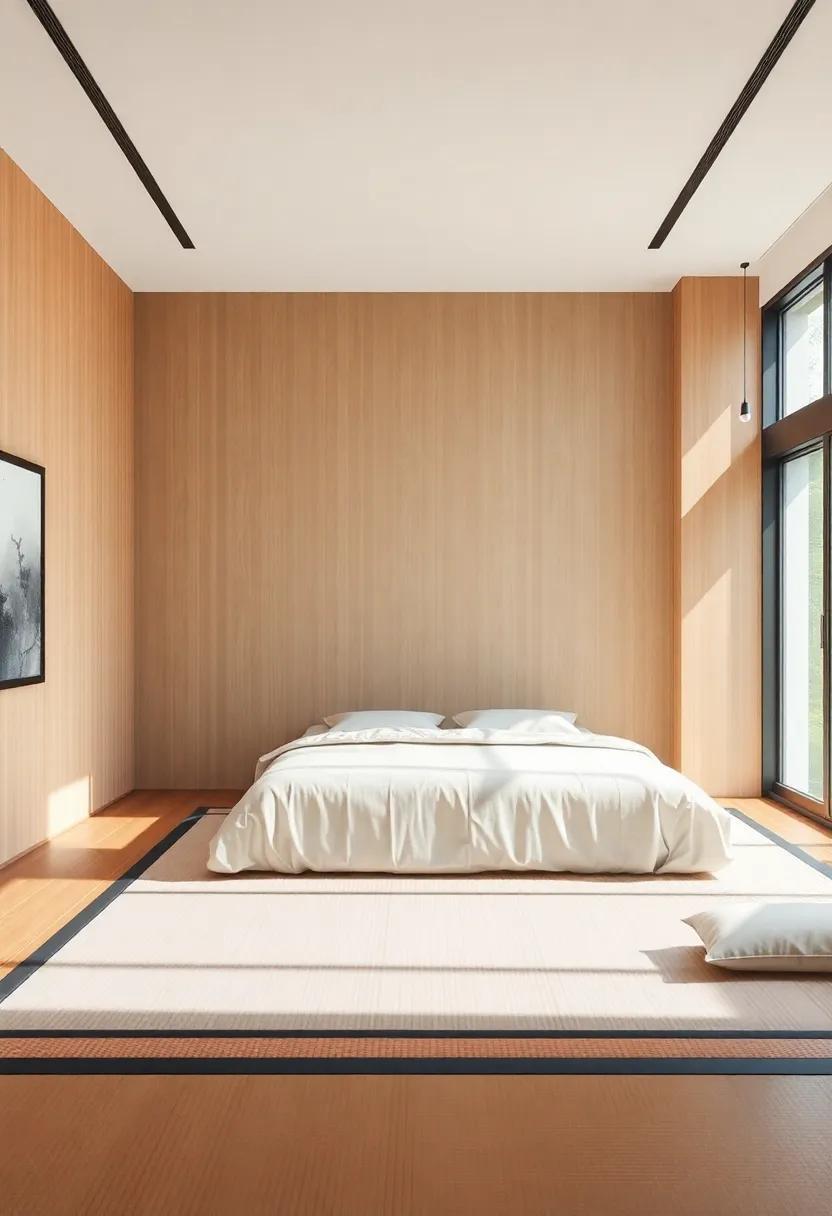In an age where the hustle and bustle of everyday life often overwhelms our senses, creating a serene sanctuary at home has never been more essential. A Japanese-inspired bedroom, with its minimalist aesthetic and life-affirming tranquility, comes as a breath of fresh air—offering a perfect retreat from the chaos of the outside world. Centered around the timeless elegance of tatami-style flooring, this listicle unveils 25 inspiring ideas that blend simplicity with sophistication. As you journey through these thoughtful concepts, you’ll discover how elements such as natural materials, muted color palettes, and serene decor can foster a calming atmosphere. From clever storage solutions to impeccable lighting suggestions, each idea aims to nurture mindfulness and promote relaxation in your personal space. Whether you’re starting from scratch or simply looking to refresh your existing decor, this guide is designed to equip you with the knowledge and inspiration needed to craft your very own tranquil oasis. Prepare to transform your bedroom into a peaceful haven that embodies the essence of Japanese design!
Embrace Minimalism: Start with a simple layout and declutter your space for a serene environment that embodies traditional Japanese design ideals
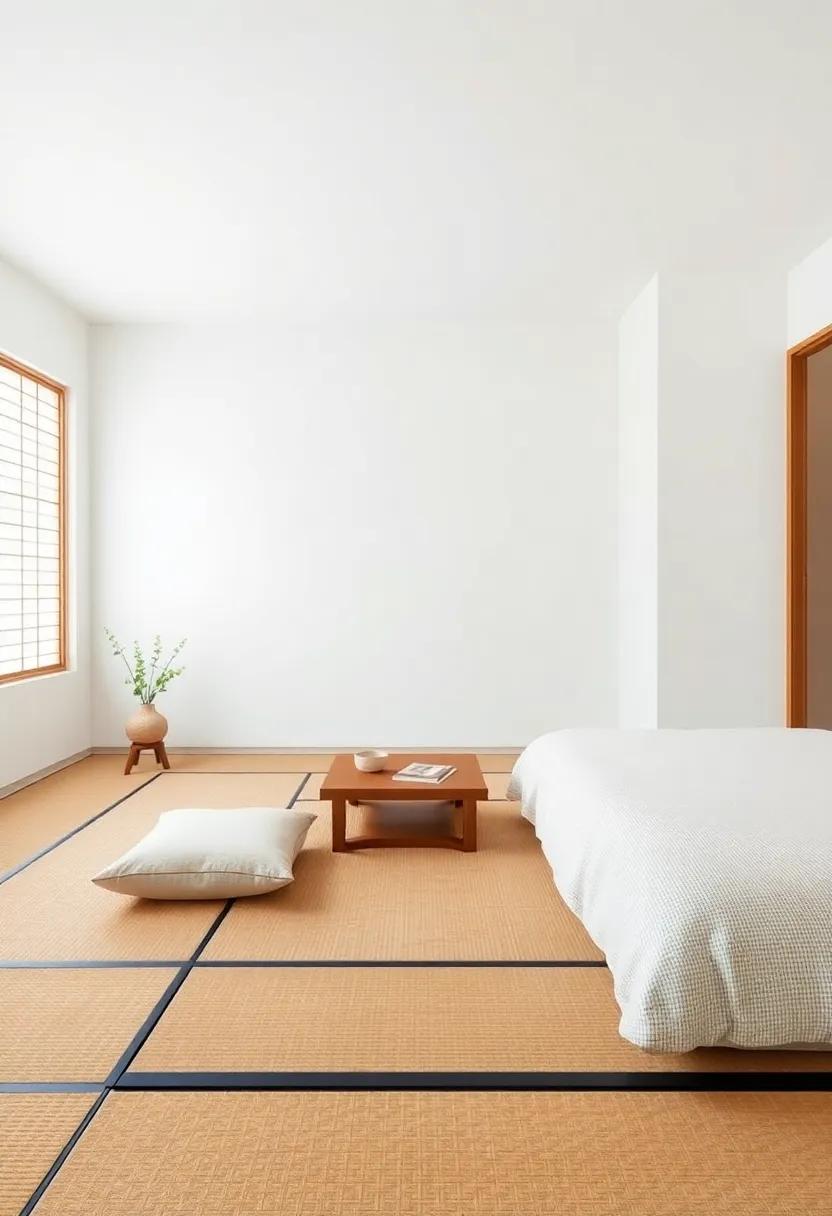
To create a tranquil environment in your Japanese-inspired bedroom, start by embracing minimalism. Focus on a simple layout that encourages openness and flow. Consider incorporating low-profile furniture such as a futon bed and a low wooden table, wich can definitely help maintain an uncluttered look. Choose color palettes that reflect nature, such as soft earth tones and muted shades, to enhance the feeling of calmness. Avoid unnecessary decor and rather opt for a few strategically placed pieces that promote serenity and reflect traditional Japanese aesthetic values.
Decluttering is vital in achieving a peaceful bedroom atmosphere. Begin by removing non-essential items from your space, allowing you to focus on what truly matters. Implement smart storage solutions to keep everything in its place, such as under-bed storage boxes or built-in cabinetry, which preserves the spaciousness of your room. You might also consider adding natural elements, like a small indoor plant or a simple vase with fresh flowers, to create a connection with nature without overwhelming the space. This curated simplicity reflects the essence of Japanese design,characterized by its honor of space and serenity.
Select Natural Materials: Use wood, bamboo, and paper for furniture and decor to create an organic atmosphere that harmonizes with tatami flooring

Incorporating natural materials into your bedroom design not only enhances the aesthetic appeal but also fosters a serene atmosphere that complements the subtle textures of tatami flooring. Opt for wooden furniture—such as minimalist beds, dressers, and side tables—that showcases the natural grain and warm tones of the wood. This choice not only adds warmth but also creates a grounding effect within the space. pair wooden elements with bamboo accents like room dividers,light fixtures,or decorative screens. Bamboo boasts an elegant look and eco-friendly qualities, enriching the organic feel of your room.
To complete your tranquil space, consider integrating paper elements in the form of shoji screens or origami-inspired decor. shoji screens not only partition the room with grace but also allow soft, diffused light to filter through, creating a calming ambiance. Additionally, using paper lanterns for lighting can add a touch of traditional Japanese charm while ensuring that the room remains well-lit without harsh glare. By combining these natural materials, you create a harmonious environment that not only supports relaxation but also honors the beauty of simplicity.
Choose a Soothing Color Palette: Opt for soft earth tones—like greens, beiges, and creams—to create an inviting and calming ambiance
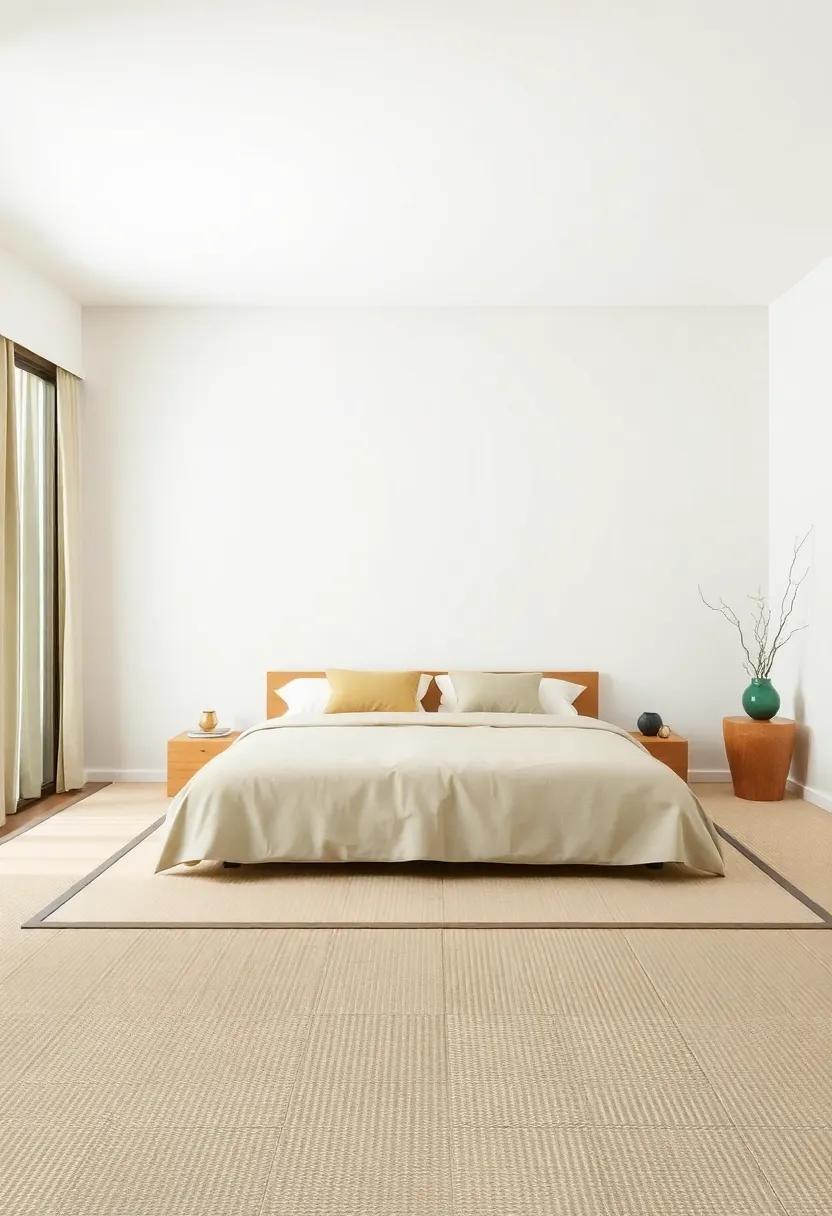
designing a serene atmosphere for your bedroom can begin with the right color choices. To evoke a sense of peace, integrating a palette of soft earth tones can make a notable impact. Think of gentle greens that mirror the tranquility of nature, warm beiges that ground the space, and creamy whites that bring lightness and airiness. These colors not only create visual harmony but also serve as the perfect backdrop for other designs in a traditional Japanese setting featuring tatami-style flooring.
When selecting your colors, consider how they influence the overall feel of the room. Soft greens,reminiscent of lush bamboo,instill a sense of calm while promoting relaxation. Meanwhile, beige tones add warmth, creating a cozy retreat. Incorporate creamy whites as accents to maintain brightness without overwhelming the senses. Below is a simple color comparison table that illustrates how these tones work beautifully together:
| Color | Effect |
|---|---|
| Soft Green | Invokes tranquility and connection with nature |
| Warm Beige | Creates a cozy, inviting atmosphere |
| Creamy White | Brings lightness and balance to the space |
Incorporate Shoji Screens: Add sliding shoji screens to separate spaces or soften light, bringing both privacy and a touch of elegance to your bedroom
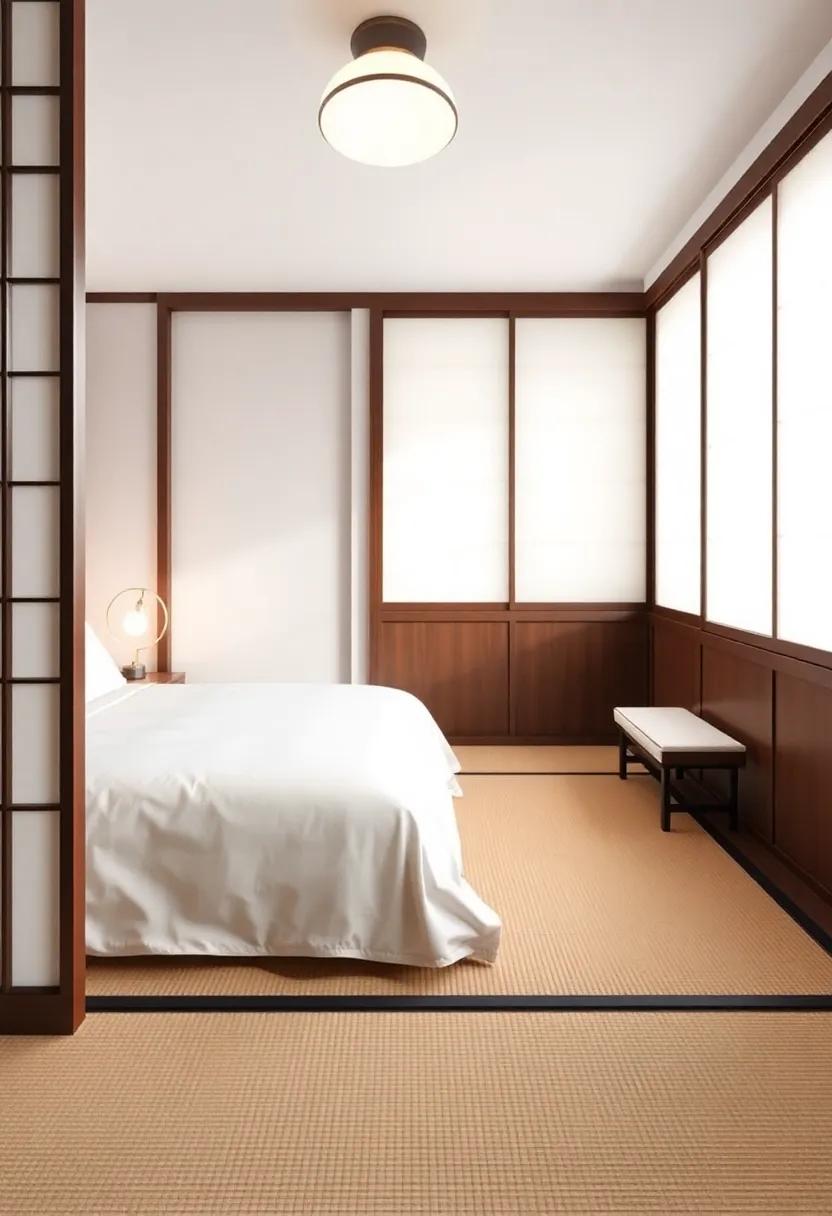
Incorporating traditional sliding panels is an exquisite way to enhance your sleeping quarters. Not only do these elegant screens serve the practical purpose of segmenting different areas, but they also imbue your bedroom with a serene, soothing atmosphere. By adding shoji screens, you can create secluded nooks for meditation or reading, allowing you to retreat from daily distractions. The delicate latticework allows just enough light to filter through, giving the space a warm, diffused glow that softens the overall ambiance.
To get the most out of shoji screens, consider different placements and designs that complement your existing decor.Here are some ideas to inspire you:
- Position a standalone shoji screen to create a cozy corner for relaxation.
- Use sliding shoji doors to separate your sleeping area from a dressing space.
- Consider translucent screens adorned with bamboo patterns to enhance the Japanese aesthetic.
| Screen Type | Material | Advantages |
|---|---|---|
| traditional rice Paper | Wood Frame | Lightweight,easy to move |
| fusuma | Wood,Paper Cover | Offers greater privacy |
| Modern Shoji | Glass,Aluminum | Stylish,durable |
Utilize Low Furniture: Select low-profile beds and tables that align with Japanese aesthetics,encouraging a sense of groundedness
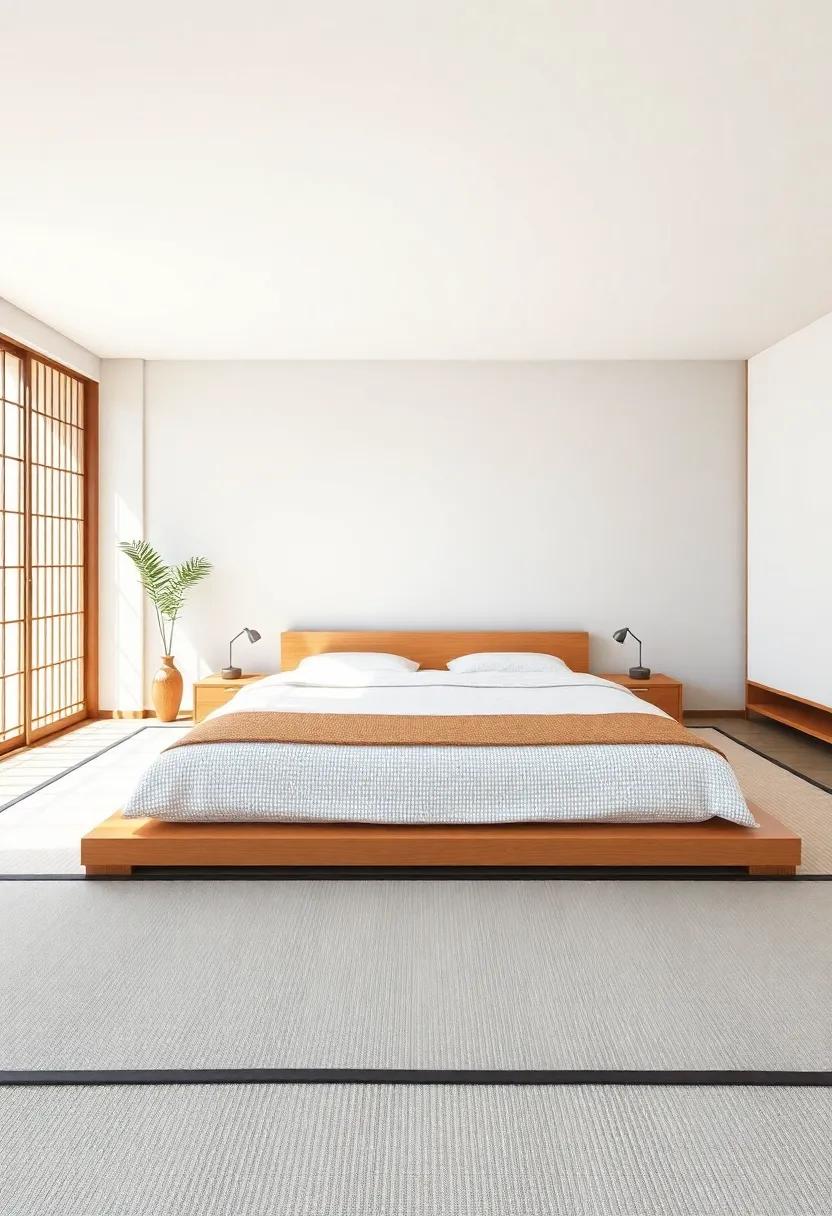
Embracing the essence of minimalism, incorporating low-profile furniture can profoundly transform your bedroom into a serene retreat. Low beds, often found in traditional Japanese design, not only save physical space but also cultivate a feeling of earthiness and connection to the ground. These beds promote a restful sleep experience, allowing for gentle, unobtrusive transitions from standing to resting. Pairing a low platform bed with a simple yet elegant bedding set crafted from natural fibers can enhance the tranquil atmosphere, inviting relaxation with every glance.
When selecting tables, opt for options that mirror the clean lines and understated elegance of Japanese decor. Low coffee tables or nightstands can serve as functional spaces for books and fragrant candles while maintaining a streamlined profile that keeps the eye focused on the room’s natural beauty.To curate a harmonious aesthetic,consider using wood or bamboo for your tables,as these materials resonate with the organic feel of tatami flooring. A simplistic design will help in creating an uncluttered look, encouraging a peaceful mindset and enhancing the overall atmosphere of tranquility.
Create a Zen Corner: Dedicate a small space for meditation or reflection with a comfortable cushion, a plant, and natural light to foster tranquility

finding a quiet corner in your home to escape the daily hustle allows you to cultivate a personal sanctuary. Start by selecting a small area, perhaps a corner of your bedroom with tatami-style flooring, where you can set up a meditation space. Choose a comfortable cushion in a gentle, calming hue, like soft gray or muted earth tones, to encourage relaxation.Enhance the serene atmosphere with a carefully selected plant; a peace lily or bamboo can bring a touch of nature indoors while improving air quality. The presence of green living elements nurtures a sense of tranquility and aid in grounding your thoughts during meditation.
To ensure this space is illuminated with a natural glow,position your meditation corner near a window that receives ample sunlight. If possible, use sheer curtains to diffuse the light softly, creating an inviting ambiance without harsh shadows. Incorporate minimal decorations like a small statue or a framed print that symbolizes peace and mindfulness. Aim for simplicity to avoid distractions; even a tiny table can serve as a place for incense or candles, enhancing the olfactory experience. By focusing on these elements, your zen corner becomes a dedicated retreat that allows you to center yourself, cultivate mindfulness, and embrace tranquility daily.
Introduce Nature Elements: Bring the outdoors in by incorporating indoor plants or a small water feature to enhance a sense of peace
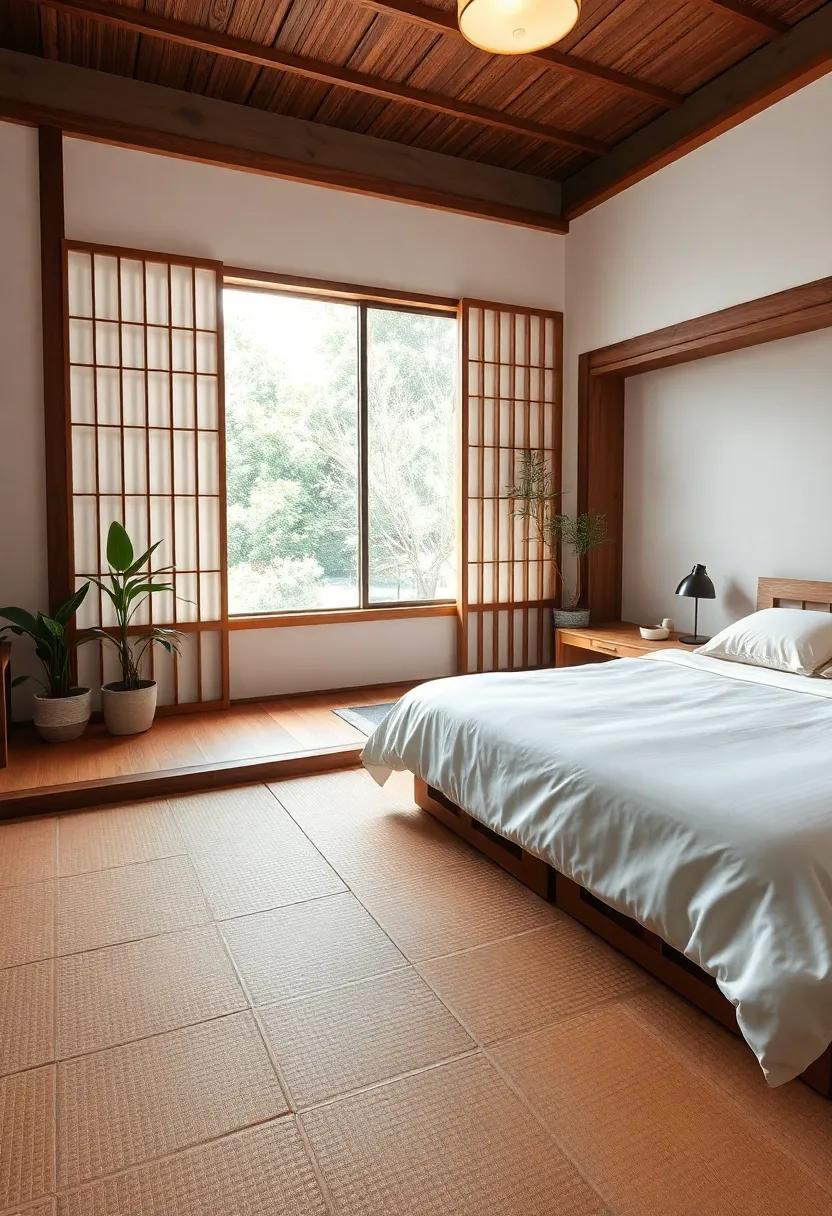
Incorporating elements of nature into your bedroom can transform the space into a serene sanctuary. Indoor plants not only enhance the aesthetic appeal but also improve air quality and bring a touch of vitality indoors.Consider placing a few potted plants on your windowsill or floors, or hanging them from the ceiling to maximize space.Varieties such as bamboo, peace lilies, or snake plants harmonize beautifully with tatami flooring and offer a gentle reminder of the tranquil outdoors.
Another stunning way to foster a calming environment is by integrating a small water feature. A tabletop fountain can produce a soothing sound of flowing water, invoking a sense of peace and relaxation. Choose a design that aligns with the minimalist aesthetic often found in japanese decor. For a more harmonious look,add stones or pebbles around the fountain to mimic a natural riverbank. Below is a simple comparison of different types of water features that work well in a Japanese-style bedroom:
| Water Feature | Description | Best For |
|---|---|---|
| Tabletop Fountain | Small units that can easily fit on any flat surface. | Limited space and easy maintenance. |
| Wall-Mounted Waterfall | Creates a stunning focal point while saving floor space. | Medium to large rooms with wall space. |
| Indoor Pond | A small pond setup with aquatic plants and fish. | Spacious rooms, offering a natural retreat. |
Use Tatami Mats Wisely: Position tatami mats to define areas in the room—consider layering or using them creatively for different functionalities
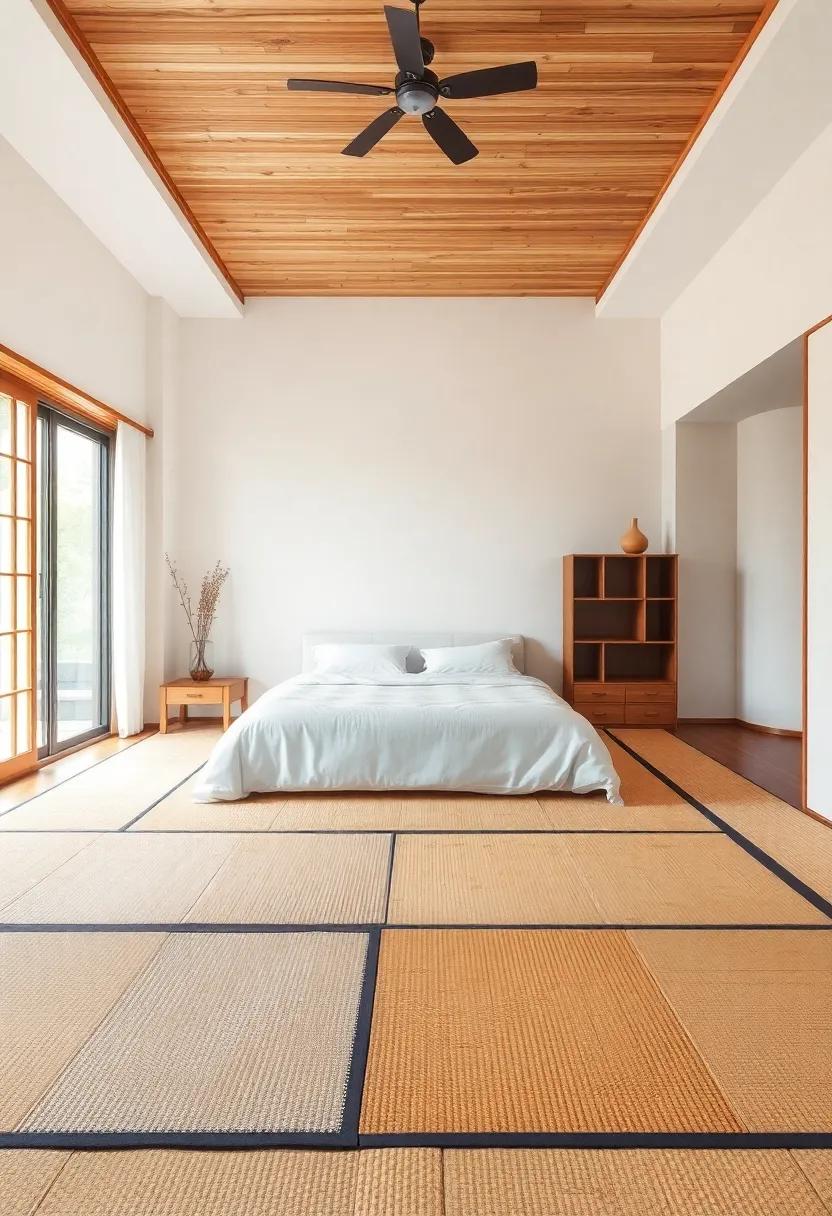
Strategically placing tatami mats can substantially enhance the functionality and aesthetic appeal of your Japanese-inspired bedroom. Start by positioning the mats to create distinct zones,such as a restful sleeping area or a cozy reading nook. To add a touch of creativity, consider layering mats of different sizes and textures. This not only adds visual interest but also provides varying levels of comfort. As an example, you could place a larger mat beneath your bed while setting a smaller, softer mat nearby for relaxation or meditation.
Moreover, think outside the box by using tatami mats to extend beyond traditional placements.Incorporate multifunctional areas by arranging mats in a way that serves multiple purposes. Here are some ideas to inspire your layout:
- Vision Board Station: Position a tatami mat in front of a low table, where you can display inspirational materials and engage in creative activities.
- yoga Space: Designate a serene corner with a portable mat; this flexible space can transform into a yoga sanctuary whenever needed.
- Reading Retreat: layer mats in a comfortable nook, accessorized with cushions for a laid-back reading spot away from distractions.
| Area | Functionality | Design Tip |
|---|---|---|
| Sleeping Zone | Restful sleeping space | Use a central larger mat under the bed |
| Activity Zone | Crafting or game area | Layer mats for a distinct, fun zone |
| Zen Corner | Meditation or relaxation | Create a serene atmosphere with soft lighting |
Design with Light in Mind: Maximize natural light with large windows and avoid harsh overhead lighting by using soft lamps instead

Embrace the tranquil essence of a Japanese bedroom by incorporating large windows that invite natural light to fill the space.Consider wall-to-wall windows to create a seamless transition between indoor and outdoor elements, allowing the beauty of nature to be a part of your decor. Use shoji screens or modular glass panels to maintain privacy without sacrificing light, and frame your views with natural materials like wood to enhance the organic feel of the room.When designing this serene sanctuary, focus on maximizing daylight hours and minimizing artificial light’s impact.
To complement your abundant natural light, opt for soft lamps that provide gentle illumination during the evenings. Use paper lanterns or wooden sconces to mirror traditional Japanese aesthetics, and ensure that the lighting is adjustable; dimmable fixtures allow you to create the perfect mood for relaxation and reflection. Avoid harsh overhead lighting that can disrupt the calm ambiance you’ve cultivated. Rather, dot your space with strategically placed soft lamps throughout the room, illuminating areas like the reading nook or the side of the tatami bed, creating a harmonious balance between light and shadow.
Incorporate Textures: Layer different textures—such as woven baskets, soft textiles, and smooth ceramics—to create depth and warmth in the space
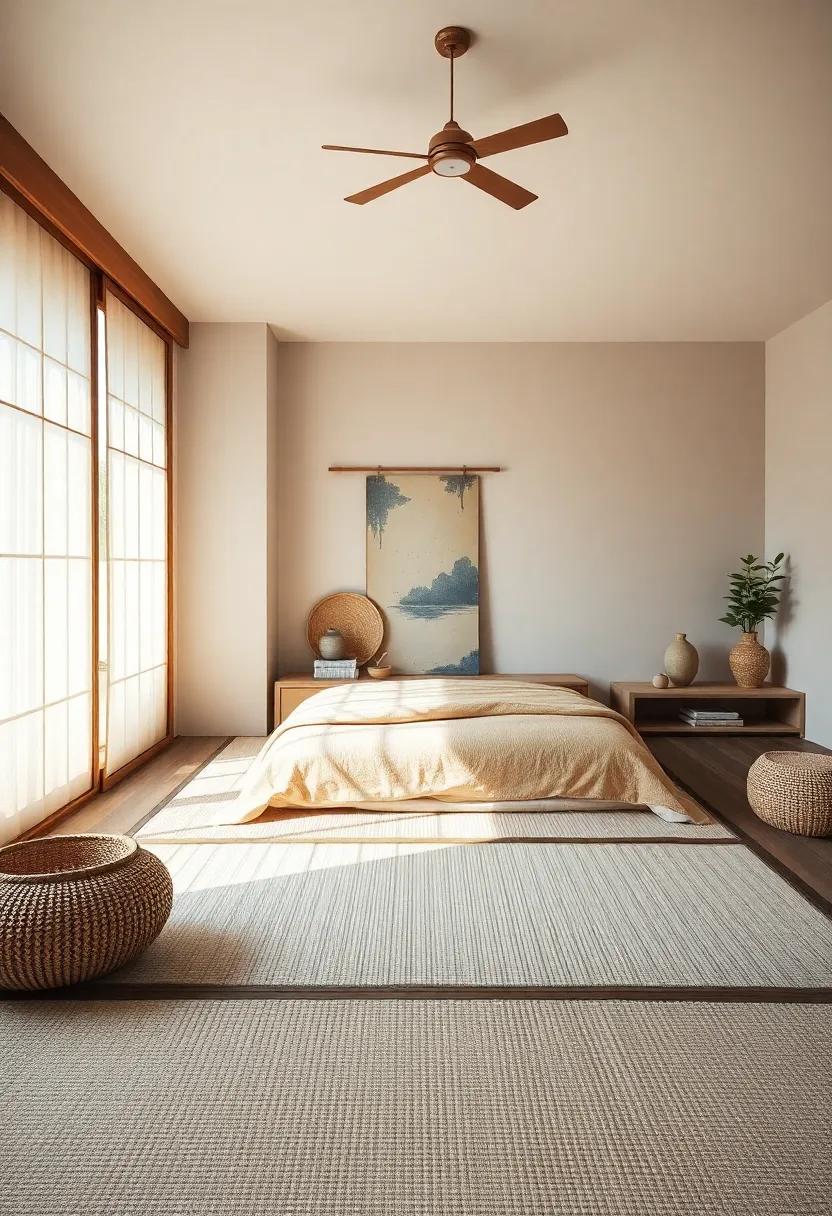
To achieve a serene ambiance reminiscent of traditional Japanese aesthetics, layering various textures is an essential technique in your design. Start with woven baskets that not only serve as storage solutions but also introduce an organic feel to the room. Their natural fibers echo the tranquil essence of nature, creating a harmonious balance with the smooth surfaces of your tatami flooring. Pair these with soft textiles, such as cushions or throws crafted from linen or cotton. These inviting materials invite relaxation and contrast beautifully against the austere textures of wood and stone, fostering an atmosphere of comfort.
Incorporating items like smooth ceramics adds another dimension of texture. Choose vases and tableware that exhibit gentle curves and polished finishes, highlighting the minimalistic beauty that is central to Japanese design.A beautifully arranged table can showcase these elements, combining the tactile softness of textiles with the sleekness of ceramics. You can even create a visual map of textures by setting up a small display on a low table, as illustrated in the table below:
| Texture | item Example | Purpose |
|---|---|---|
| Woven | Basket | Storage & Natural Element |
| Soft | Cushions | Comfort & Warmth |
| Smooth | Ceramics | Minimalist Aesthetic |
Personalize with Art: Choose serene artwork that resonates with you, opting for landscapes or abstract pieces that evoke a calm feeling
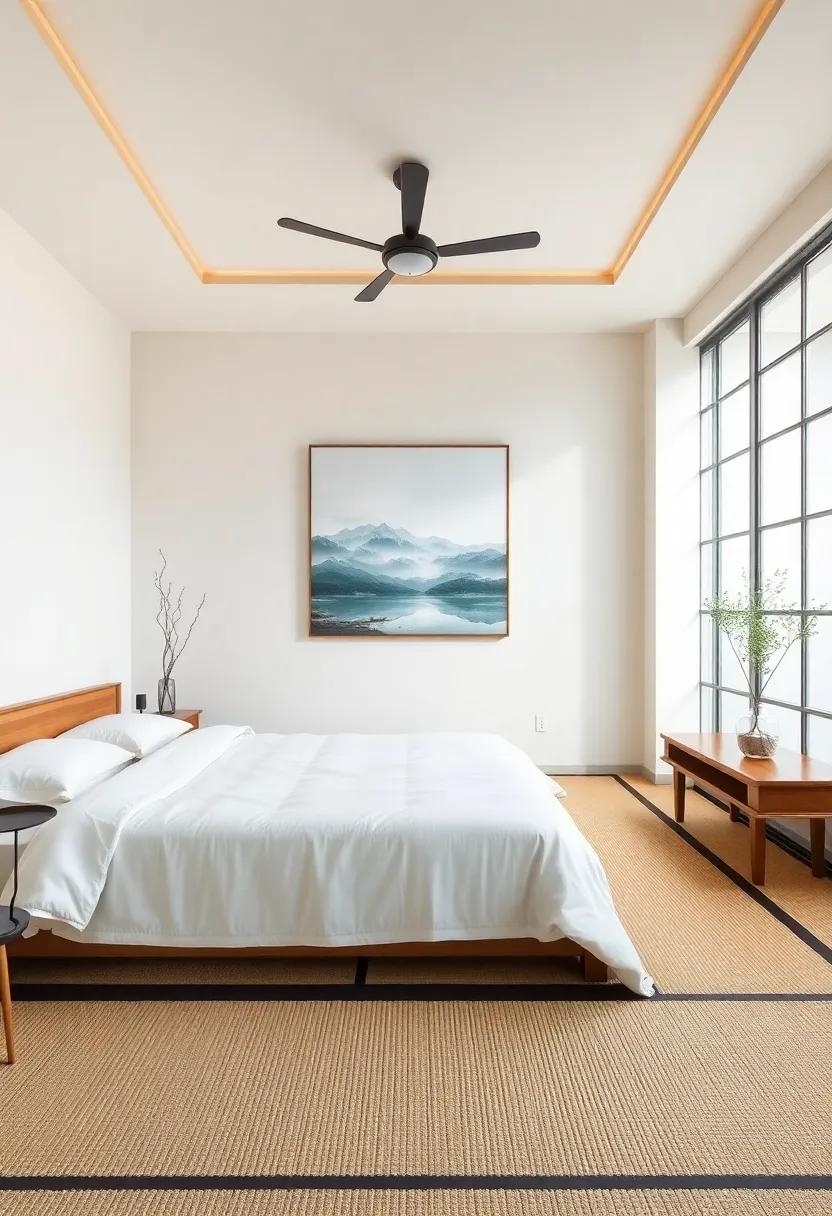
Enhancing your serene space with thoughtfully selected artwork can elevate the tranquility of your Japanese bedroom. Focus on landscapes that depict serene nature scenes, such as misty mountains or calm waters, which can transport you to peaceful vistas. Additionally,consider abstract pieces that use soft colors and fluid forms to evoke a sense of calmness. Look for artwork that reflects your personal experiences or dreams, as this connection makes the piece resonate even more deeply, creating a unique ambiance tailored just for you.
When choosing artwork, take into account how the pieces will harmonize with your tatami flooring and other elements within the space. You might want to explore:
- minimalist paintings that complement the simplicity of the design
- Nature-inspired prints that echo the outdoors
- japanese calligraphy art that adds cultural depth
- Framed photographs of tranquil settings
Remember, the key is to create a cohesive atmosphere where each piece contributes to an overall sense of peace and serenity. By surrounding yourself with art that speaks to your soul, you cultivate a sanctuary that feels both personal and relaxing.
Opt for Futon Bedding: Use traditional futons for bedding, allowing for easy storage during the day to maintain an open and airy feel
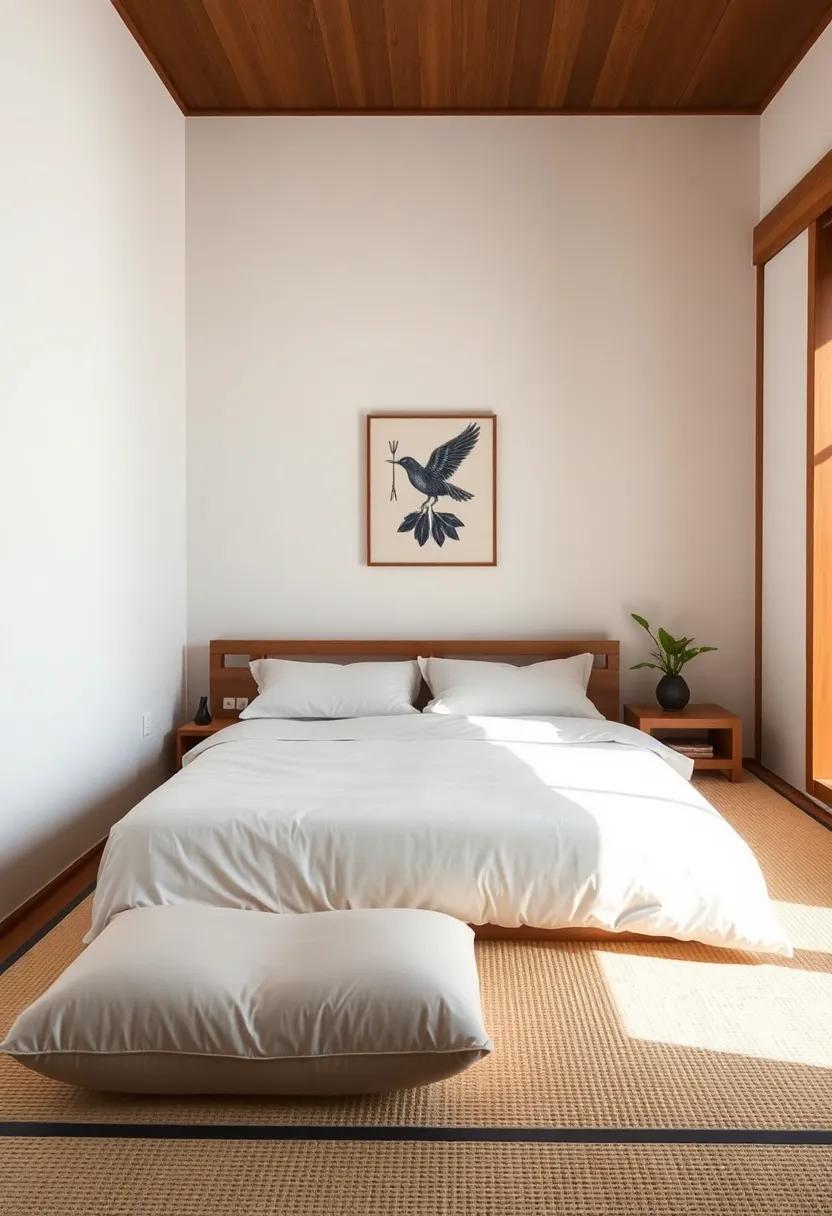
In a traditional Japanese bedroom, the emphasis is on simplicity and minimalism. Futon bedding is an excellent choice, as it not only offers comfort but also transforms your space into a flexible sanctuary. During the day, these lightweight sleeping arrangements can be easily folded and stored away, allowing your room to serve multiple purposes while creating a serene atmosphere. When using futons, opt for natural materials such as organic cotton or linen to enhance the overall calming effect. These fabrics not only breathe well but also blend seamlessly with tatami-style flooring, further accentuating the natural aesthetics of your space.
Consider incorporating a few thoughtful elements into your futon setup. layered bedding can add texture and warmth while remaining functional. Choose calming colors,such as soft whites,muted greens,and earthy browns,to evoke a peaceful vibe. An accompanying futon cover can protect your bedding and add an extra style dimension. Here are a few key elements to enhance your futon experience:
- Soft throw Pillows: Incorporate round or rectangular cushions for added comfort.
- Minimalist Bedside Tables: Use simple wooden or bamboo stands to maintain an uncluttered look.
- Sustainable materials: Choose bedding that is eco-friendly and ethically produced.
| Futon Features | Description |
|---|---|
| Easy Storage | Foldable design simplifies daily storage and enhances floor space. |
| Natural comfort | Opt for organic materials for improved health and well-being. |
| Versatile Design | Works well in various bedroom styles, from modern to traditional. |
Build Harmony with Symmetry: Arrange furniture and decor symmetrically to create balance, which is a key element in Japanese design philosophy
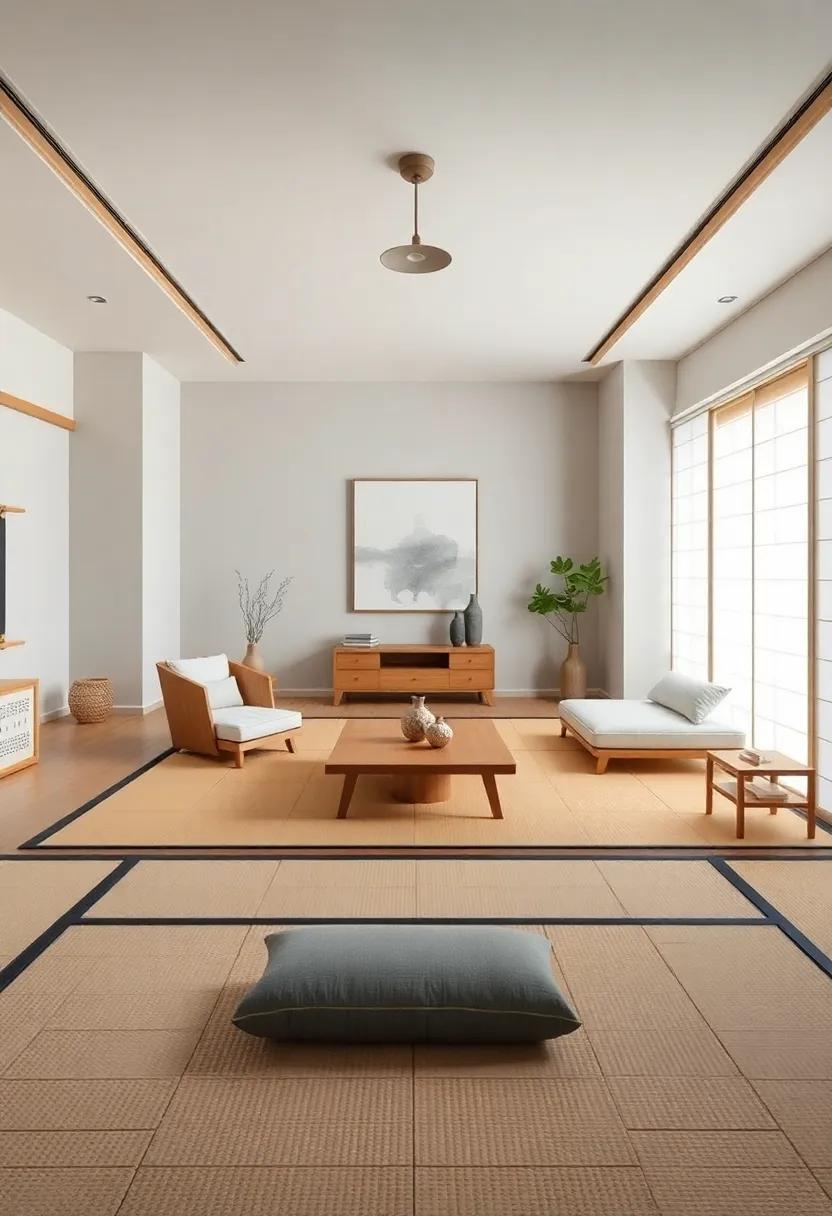
Creating a harmonious environment in your Japanese bedroom requires a thoughtful arrangement of furniture and decor to achieve a sense of balance and tranquility. Using symmetry in your layout can significantly enhance the peaceful atmosphere characteristic of Japanese design. When arranging your space, consider these ideas:
- Equidistant Nightstands: Place identical nightstands on either side of the bed, maintaining equal distance from the edges. This simple change creates visual stability.
- Matching Lamps: Use two matching lamps on the nightstands to illuminate the space evenly and foster a cohesive look.
- Symmetrical Artwork: Hang two pieces of artwork with similar dimensions on opposite walls. This draws the eye across the room, reinforcing balance.
- Uniform Pillows: Arrange an equal number of pillows of the same size on each side of the bed, stacking them to create height and dimension.
Embracing symmetry also extends beyond furniture arrangement to the choice of decor and accessories. Select items that echo this principle to cultivate a peaceful aesthetic:
| Decor Item | Symmetrical Pairing |
|---|---|
| Plants | Two identical potted plants flanking the window |
| Textiles | Matching throw blankets on either side of the bed |
| Screens | Two folding screens positioned symmetrically in the room |
by thoughtfully incorporating these elements into your design, you can create a serene retreat that embodies the principles of harmony and balance, making your space feel both intentional and inviting.
Add a Touch of Futuristic Minimalism: Blend modern minimalist elements with traditional Japanese features to create a space that feels contemporarily tranquil
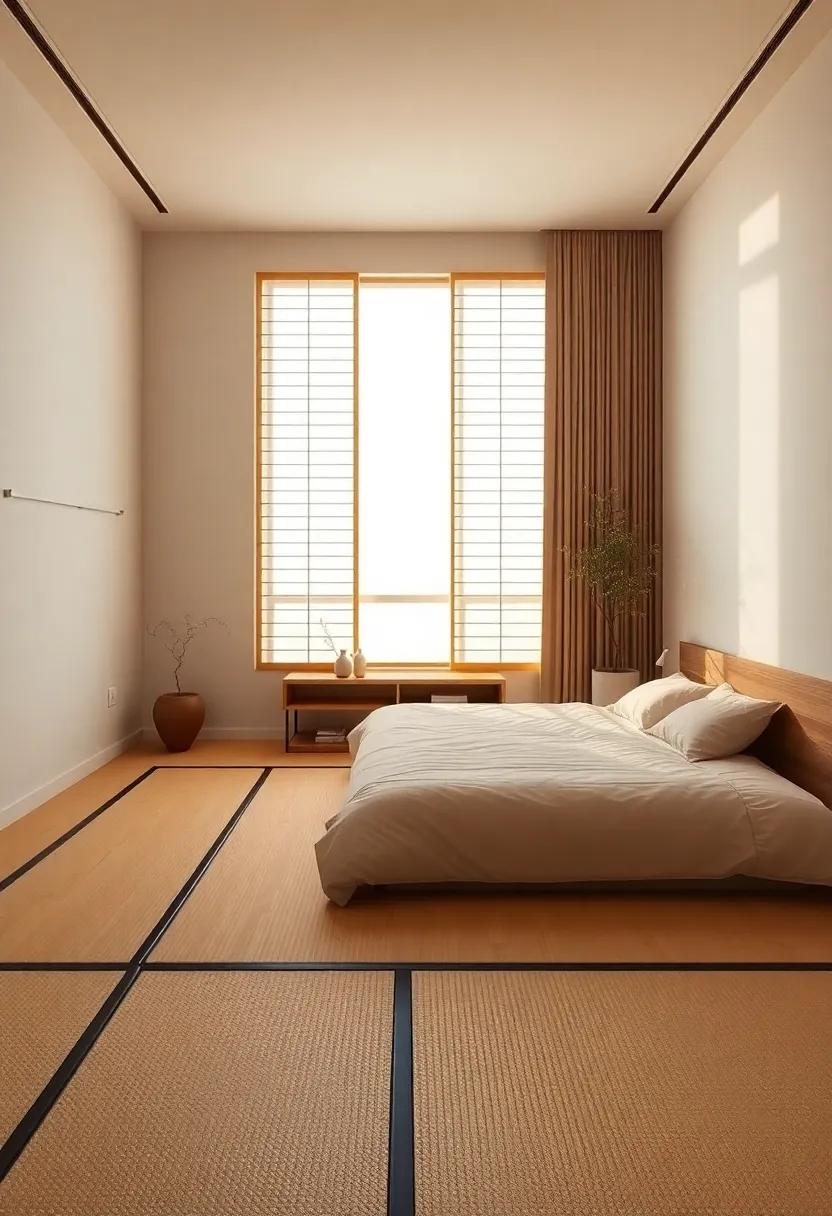
To achieve a serene atmosphere that echoes modern sensibilities while honoring traditional aesthetics, consider integrating natural textures and subtle colors.Use a palette of soft beiges, creamy whites, and muted earth tones to set a calming backdrop. Incorporate elements like a low-profile platform bed crafted from organic materials to maintain simplicity.Accentuate this centerpiece with shoji screens that serve not only as room dividers but also as artful displays of light and shadow, allowing for a dynamic interplay throughout the day.
Furnish your space with minimalist decor that combines functionality and elegance. Think of low furniture, such as sleek benches and side tables, that promote a sense of openness. Accessories could include intricate pottery or handmade textiles that introduce warmth without overwhelming the senses. Utilize built-in shelving to maintain an uncluttered look while showcasing carefully selected plants or artisan crafts, seamlessly marrying the old with the new. This delicate balance ensures your bedroom remains a tranquil retreat, inviting relaxation and mindfulness.
Use Light Fabrics: Choose airy curtains and bedding made from natural fabrics like linen or cotton to enhance a peaceful atmosphere
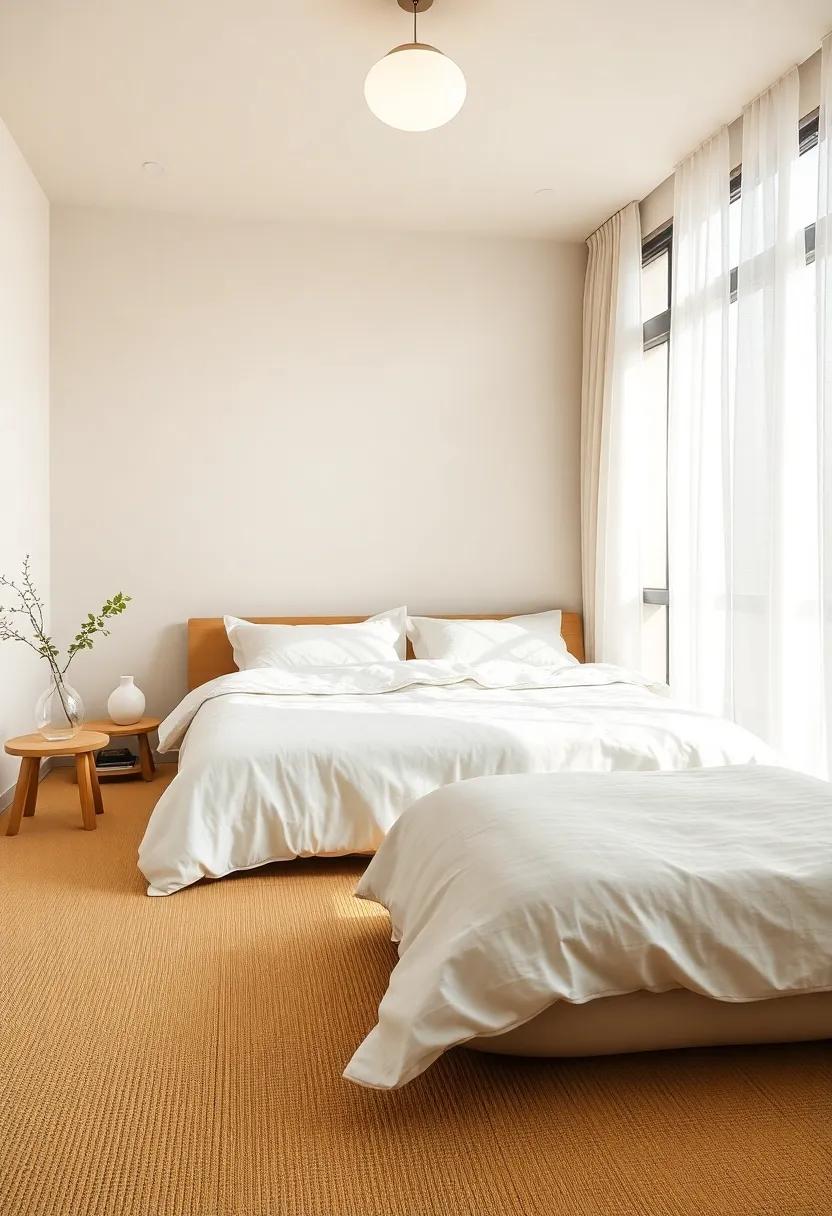
creating a serene sanctuary in your Japanese-inspired bedroom begins with selecting fabrics that breathe and evoke a sense of tranquility. Linen and cotton are ideal choices, not only for their naturally lightweight qualities but also for the soothing textures they provide. airy curtains that billow gently in the breeze will diffuse harsh sunlight while maintaining a sense of openness. Opt for soft, muted tones or delicate patterns to keep a tranquil vibe, allowing the natural beauty of the tatami flooring to shine through.
When it comes to bedding, choose linens that are both comfortable and visually calming. Duvets and sheets made from these materials can help regulate temperature, ensuring a restful night’s sleep. Consider the following options for your bedding ensemble:
| Fabric Type | benefits |
|---|---|
| Linen | Highly breathable,softens with each wash |
| Cotton | Durable,versatile,available in a variety of styles |
| Bamboo | Hypoallergenic,moisture-wicking,eco-friendly |
By prioritizing these airy fabrics,you will not only enhance the comfort of your space but also cultivate an atmosphere of peace and relaxation,perfectly harmonizing with the minimalistic beauty of a tatami-style bedroom.
Integrate Japanese Ceramics: Showcase beautiful pottery as decorative elements or functional pieces to add character and heritage to the room

Japanese ceramics embody a timeless elegance that can seamlessly blend into the serene aesthetic of a tranquil bedroom. Consider incorporating ornate hand-crafted vases or minimalistic plates on your shelves or bedside tables to create visual interest. Each piece tells a story, reflecting the craftsmanship of different regions in Japan, such as the delicate Arita porcelain or earthy Bizen pottery. These ceramics not only serve as beautiful decorative elements but can also be practical by doubling as functional items for your personal sanctuary. you can use a lovely teapot, adorned with traditional patterns, to create a cozy tea corner or elegant bowls for storing small personal items like jewelry or trinkets, adding both beauty and utility to your space.
To enhance the character of your room further, consider displaying a curated collection of ceramic planters with small indoor plants, introducing a touch of nature into your decor. The harmony achieved by blending ceramics with greenery can evoke feelings of peace and balance, essential for a Japanese-inspired space. For larger pieces, a statement floor vase can add height and elegance to a corner of the room, while ceramic lanterns can create soft, ambient lighting during the evening. Arrange these pieces thoughtfully to achieve a cohesive look that celebrates the rich heritage of Japanese artistry.
Install a Tansu: Use a traditional japanese chest for storage, combining functionality with a piece of history that adds charm to your bedroom
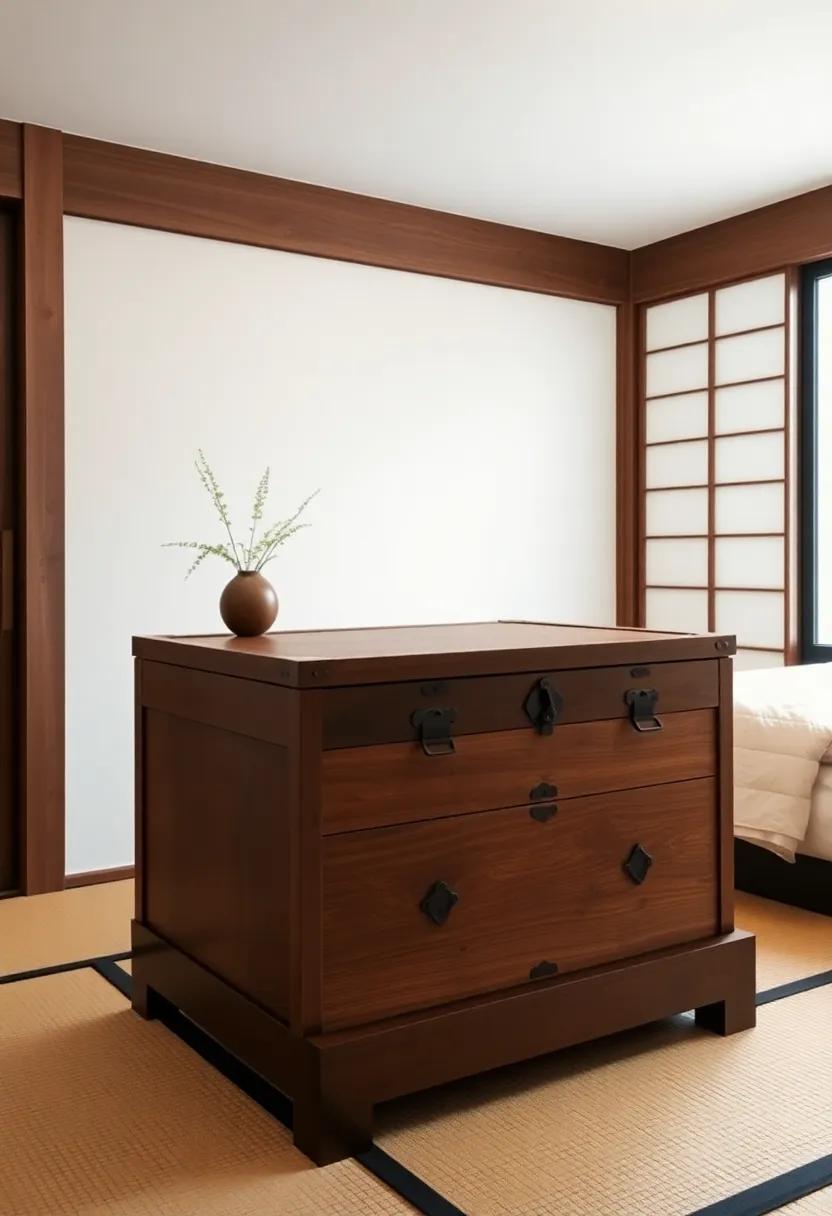
Incorporating a Tansu, a traditional Japanese chest, into your bedroom can elevate both the functionality and aesthetic appeal of the space.These beautifully crafted chests are not only practical for storage but also serve as a remarkable centerpiece that tells a story of craftsmanship and history. Consider positioning a Tansu at the foot of your bed or beneath a window, where it can serve dual purposes as a storage unit and a display surface for treasured items. The elegant wood finish, often adorned with intricate iron hardware, enhances the serene ambiance of a Japanese-inspired room.
When selecting a Tansu, keep in mind the following features to amplify its charm:
- Material: Look for authentic wood types like cedar or pine for durability and a natural feel.
- Size: Ensure it complements the dimensions of your room without overwhelming the space.
- Color: Choose a finish that harmonizes with your tatami flooring and other decor elements.
- Design: Opt for intricate carvings or a minimalist style that reflects traditional Japanese aesthetics.
To make the most of your Tansu’s functionality, consider transforming its top into a decorative display. Use it to showcase:
| Decorative Item | Description |
|---|---|
| Succulents | Add greenery with minimal upkeep. |
| Books | Stack a few favorite reads for easy access. |
| Art objects | Display small sculptures or traditional pottery. |
Create a Murakami-Style Nook: Take inspiration from the works of Takashi murakami and design a vibrant corner that contrasts with the overall serene environment
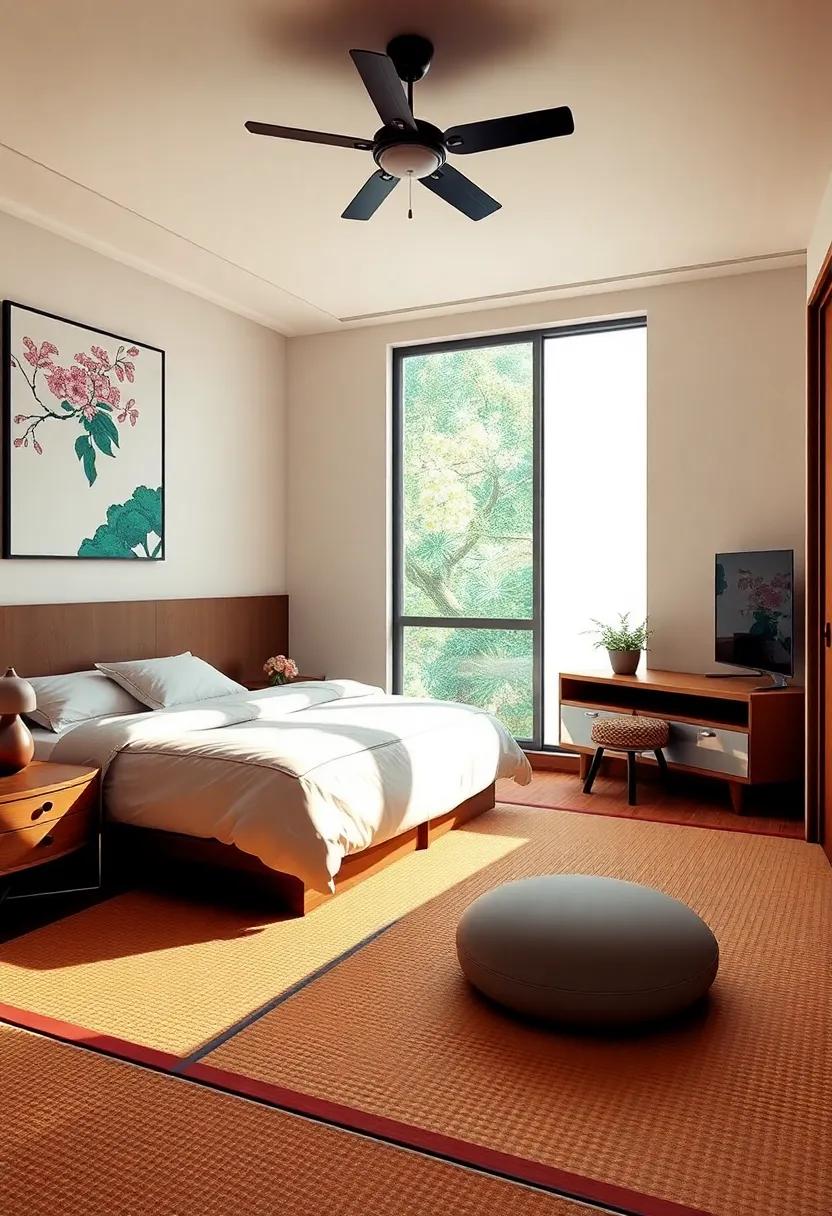
To establish a lively yet harmonious nook reminiscent of Takashi Murakami’s vibrant aesthetic, consider incorporating pieces that feature shining colors and playful designs. Use a statement mural or wall art that captures his signature motifs, perhaps a large canvas depicting cheerful flowers or whimsical creatures that pop against the serene backdrop of your bedroom. Arrange a cozy seating area with colorful cushions that invite relaxation while echoing the bright themes of Murakami’s artwork, effortlessly transforming the space into a joyful retreat.
Layer this vivid nook with distinctive decor elements to enhance its artistic flair. Add decorative items such as:
- Colorful throw pillows with abstract patterns.
- Artistic rugs that boast playful designs.
- Statement vases or plant pots featuring Murakami’s styles.
- Framed prints that celebrate Japanese pop art.
By blending these elements, you can create a lively yet complementary corner, providing a beautiful contrast to the calming serenity of your tatami-style bedroom.
Hang a Kakejiku: Display a traditional Japanese scroll painting on the wall to provide a focal point filled with cultural significance
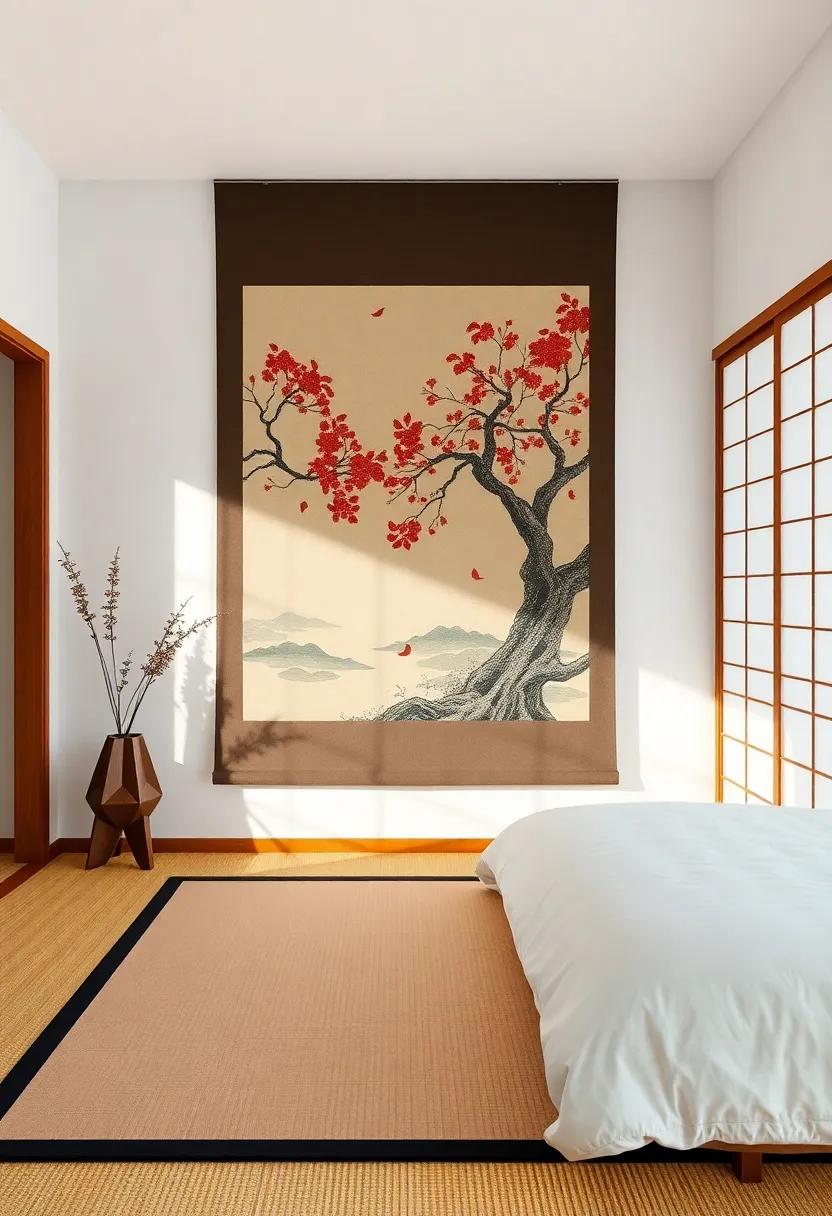
One of the most impactful ways to embrace the serene aesthetics of a Japanese bedroom is to hang a kakejiku, or traditional scroll painting, on the wall. These exquisite works of art often depict nature, calligraphy, or past scenes, making them a perfect conversation starter while infusing your space with a sense of tranquility and cultural depth.When selecting a kakejiku, consider the following elements to ensure it complements your environment:
- Background Color: Opt for hues that harmonize with your bedroom’s color palette, such as earthy tones or calming blues and greens.
- Theme: Choose a painting that reflects the season, as kakejiku are frequently enough changed to signify different times of the year, promoting a dynamic yet grounded atmosphere.
- Size: The scale of the scroll should be proportional to the wall space, creating a balanced focal point without overwhelming the room.
to properly display your kakejiku, positioning is key. center it over a tatami mat area, perhaps above a low table or seating arrangement, allowing its beauty to be fully appreciated. In addition, follow these tips to enhance the presentation:
| Display Tips | Description |
|---|---|
| Lighting: | Use soft spotlights or sconces to highlight the scroll’s details while maintaining a warm ambiance. |
| Layering: | Consider layering the kakejiku with other decorative elements, such as indoor plants or minimalist shelves. |
| Maintenance: | Keep the scroll away from direct sunlight to prevent fading, and handle it gently to preserve its delicate nature. |
Consider an Indoor Zen Garden: If space allows, create a mini zen garden with sand, stones, and small plants for a unique sculptural element
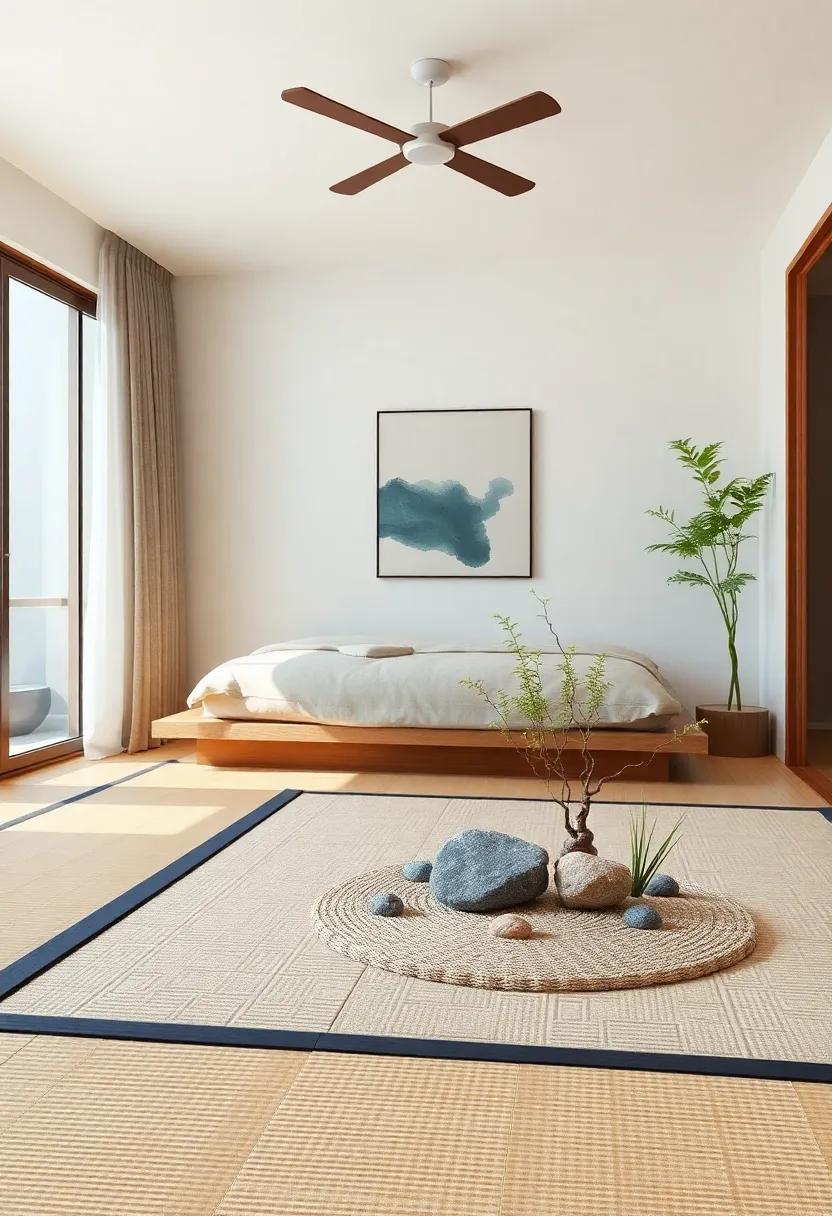
Transforming a corner of your bedroom into an indoor oasis can enhance the tranquility of your space.A mini Zen garden invites calm and promotes mindfulness,providing a tactile experience that soothes the senses. Start by choosing a shallow wooden or ceramic tray to contain the elements. Layer fine white sand to represent purity and simplicity, then create gentle patterns using a rake or even your fingers, which encourages meditative reflection. Add smooth pebbles or small stones to introduce a sense of balance and contrast, allowing you to design your mini landscape in a way that speaks to you.
To elevate your Zen garden, consider including small plants such as succulents, ferns, or moss, which contribute lushness without overwhelming the space. Opt for easy-care varieties that require minimal maintenance, ensuring your garden remains serene and unburdened. think about incorporating natural wood elements, like driftwood or bamboo, to enhance the authentic feel of a traditional japanese garden. With this miniature retreat in your bedroom, you’ll not only beautify your environment but also cultivate a space that encourages relaxation and mindfulness.
Implement natural Soundscapes: Use sound machines or play gentle nature sounds to enhance tranquility and provide a soothing background to your space
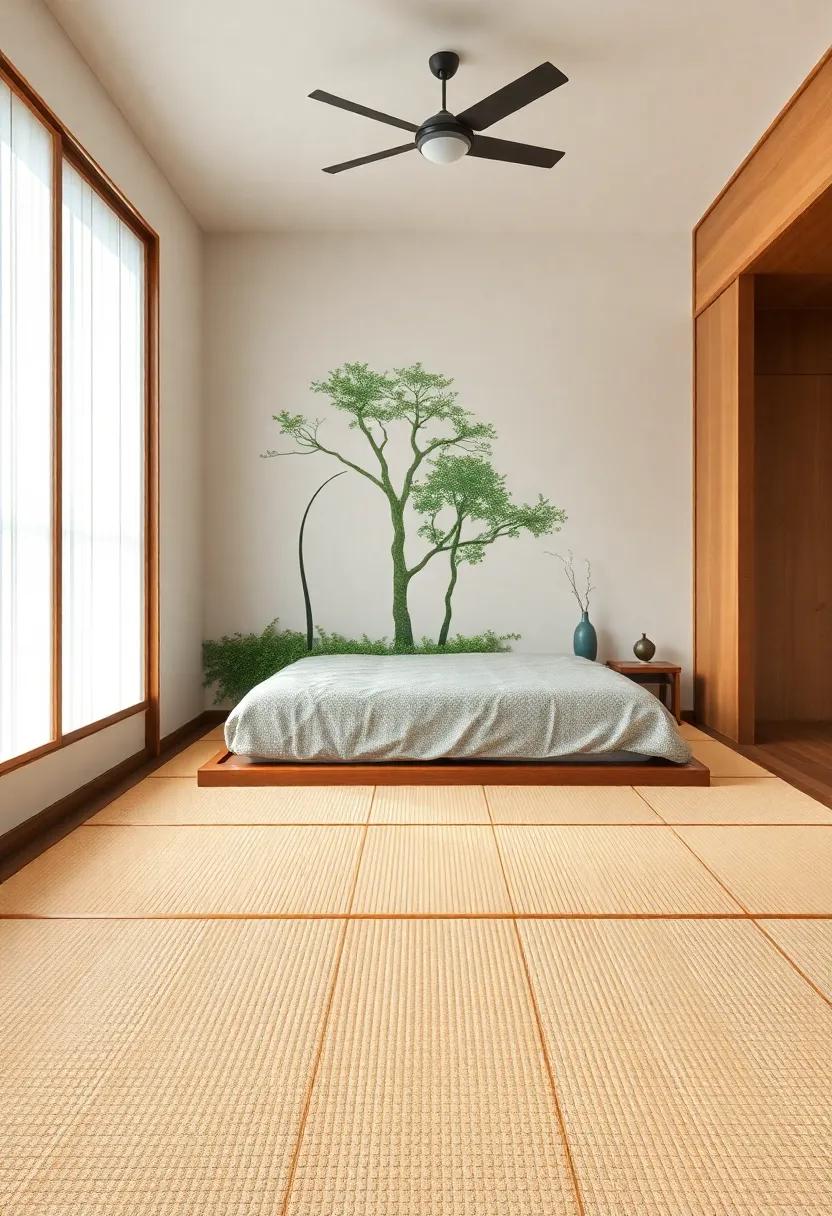
Incorporating natural soundscapes into your Japanese bedroom design can significantly elevate the overall sense of calm. Start by investing in high-quality sound machines that can replicate soothing elements from the natural world, such as gentle rain, rustling leaves, or distant ocean waves. you might also consider building a playlist of gentle nature sounds to play softly in the background. This auditory layer complements the minimalist aesthetic of tatami flooring and promotes a serene atmosphere, making it easier to unwind after a long day.
To create the perfect soundscape, think about the following options:
- Nature Sound Machines: These often come equipped with multiple sound settings and timers, allowing you to tailor your auditory environment.
- Smart Speakers: Utilize devices that can stream relaxing music or nature sounds from your favorite apps.
- Water Features: Incorporating a small indoor water fountain can provide calming water sounds, enhancing the tranquil vibe.
- Live Plants: Combining sound with the visual appeal of greenery can create a multi-sensory experience.
- meditation Apps: Use guided sessions that include soft nature sounds to help deepen your relaxation.
Choose Meaningful Objects: Curate a selection of meaningful possessions that evoke memories or feelings, ensuring they fit harmoniously in the space
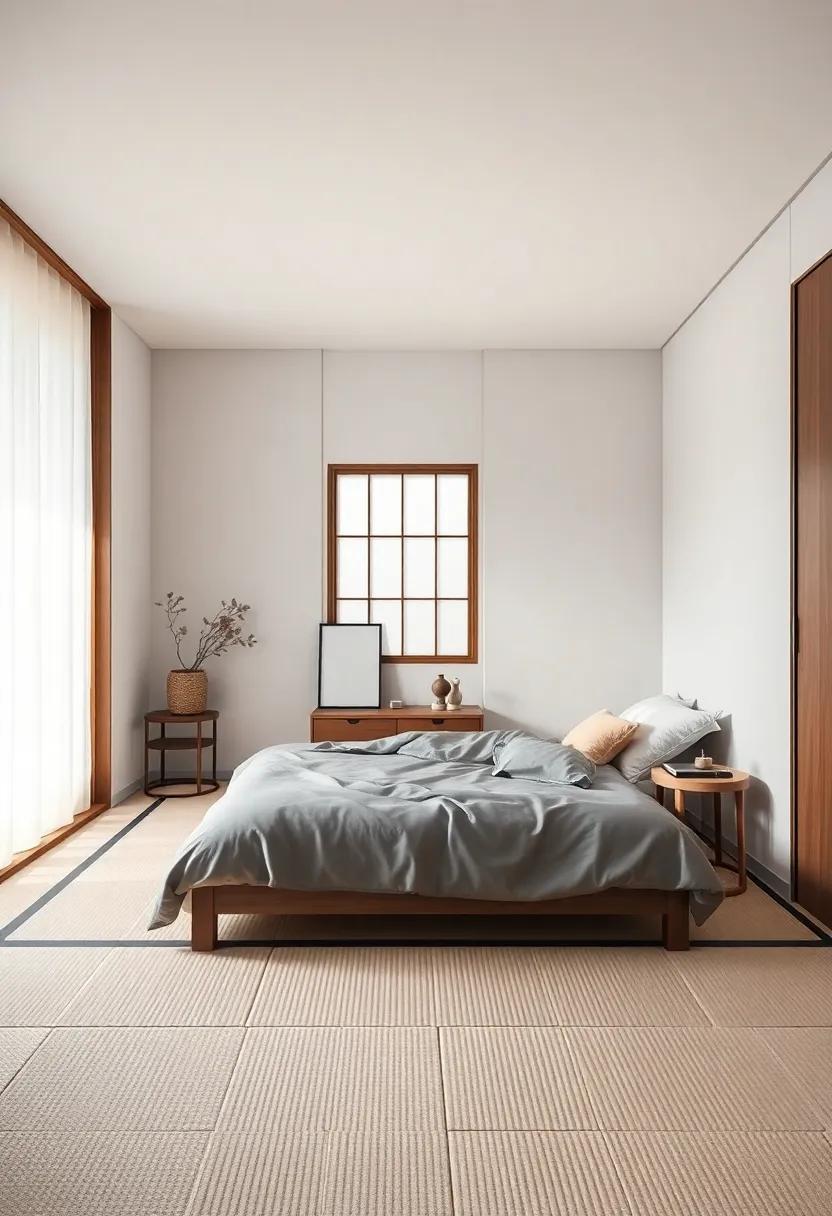
In crafting a peaceful retreat, it’s essential to select items that not only serve a purpose but also resonate with your personal journey. Start by gathering possessions that recall significant moments or people in your life. As a notable example, a beautifully framed photograph of a cherished memory or a hand-painted vase from a travel adventure can add warmth and personality to your space. These treasures should complement the essence of a Japanese bedroom, where simplicity meets meaning. Consider incorporating:
- Family heirlooms that tell stories of your heritage
- Artisanal crafts from local artisans, reflecting the beauty of understated décor
- Books that have inspired you, displayed on minimalist shelves
- Plants, such as bonsai or bamboo, serving as living reminders of growth and tranquility
Next, focus on how these items interact within the room’s overall aesthetic. Arrange the curated objects mindfully,ensuring they flow with the natural lines of the tatami flooring and the soft lighting typical of a serene bedroom.Balance is key; avoid cluttering surfaces and rather create a cohesive look. You might want to consider:
| object Type | Suggested Placement |
|---|---|
| Framed Photos | On tatami shelf or low table |
| Artisanal Crafts | Accent table or window ledge |
| Bonsai Plant | Near a light source, like a shoji screen |
| Books | Stacked neatly on a bedside table |
Think about the Scent: Incorporate essential oil diffusers or incense to create an aromatic environment that fosters relaxation and calmness
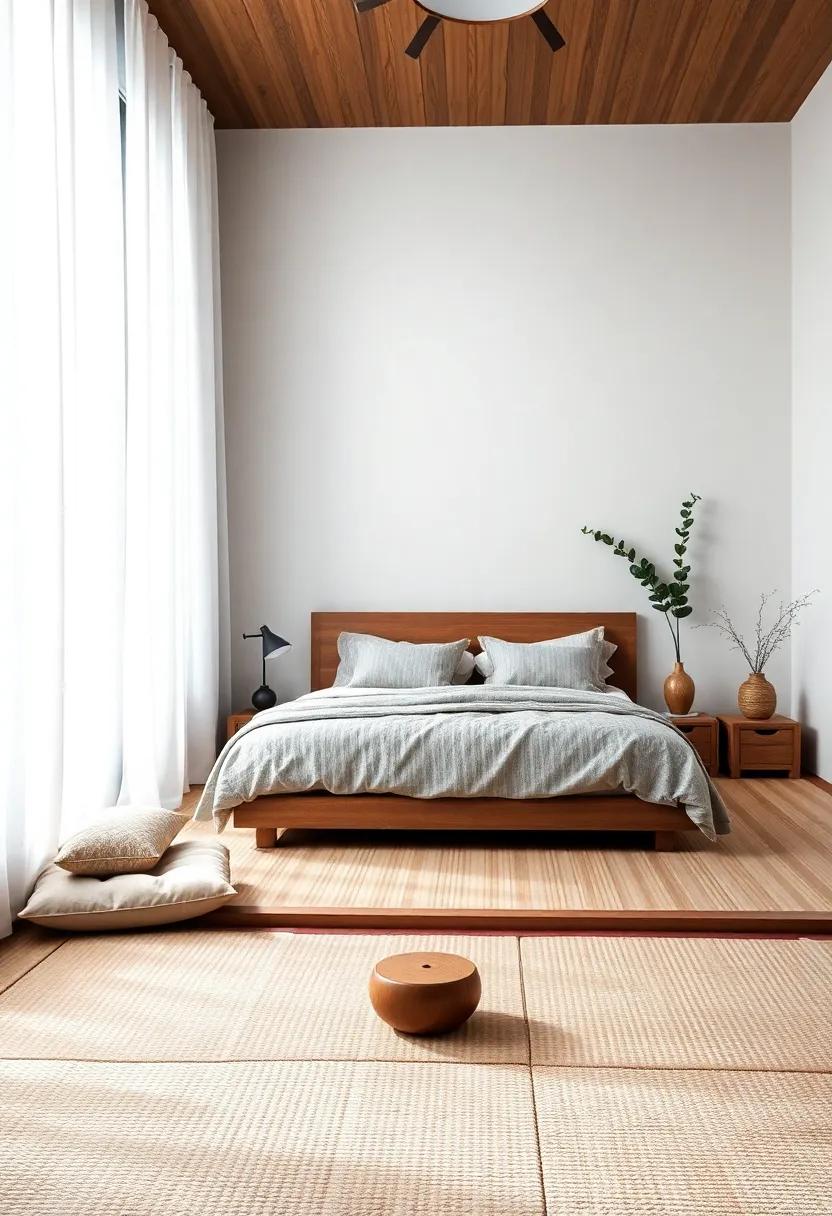
Consider infusing your sanctuary with comforting aromas using essential oil diffusers or fragrant incense. The delicate wafts of natural scents can transform your space into a haven of tranquility,creating a sensory experience that promotes relaxation and serenity. Some popular essential oils for enhancing calmness include:
- Lavender: Known for its soothing properties, perfect for winding down.
- Chamomile: Offers a sweet, calming scent that eases tension.
- Sandalwood: Provides a warm, earthy aroma that grounds the spirit.
- Peppermint: refreshes the mind and uplifts the mood.
To complement these scents, consider creating a designated corner in your bedroom specifically for this aromatic experience. Place your diffuser or incense holder on a small side table adorned with bonsai or other minimalist décor to maintain the room’s harmony. You can also explore the benefits of different incense varieties; as a notable example:
| incense Type | Benefits |
|---|---|
| Green Tea | Promotes clarity and mindfulness. |
| Frankincense | Enhances meditation and spiritual connection. |
| Vanilla | Creates a warm, inviting atmosphere. |
| Jasmine | Alleviates anxiety and induces sleep. |
Integrating these elements not only elevates the aesthetic of your space but also nurtures your mental well-being. Allow the enchanting aromas to guide you into a world of peace and rejuvenation, making your bedroom the ultimate retreat from everyday stresses.
Reflect on the Floor Space: Allow the tatami mats to be the focal point; arrange furniture around them to highlight their beauty and utility
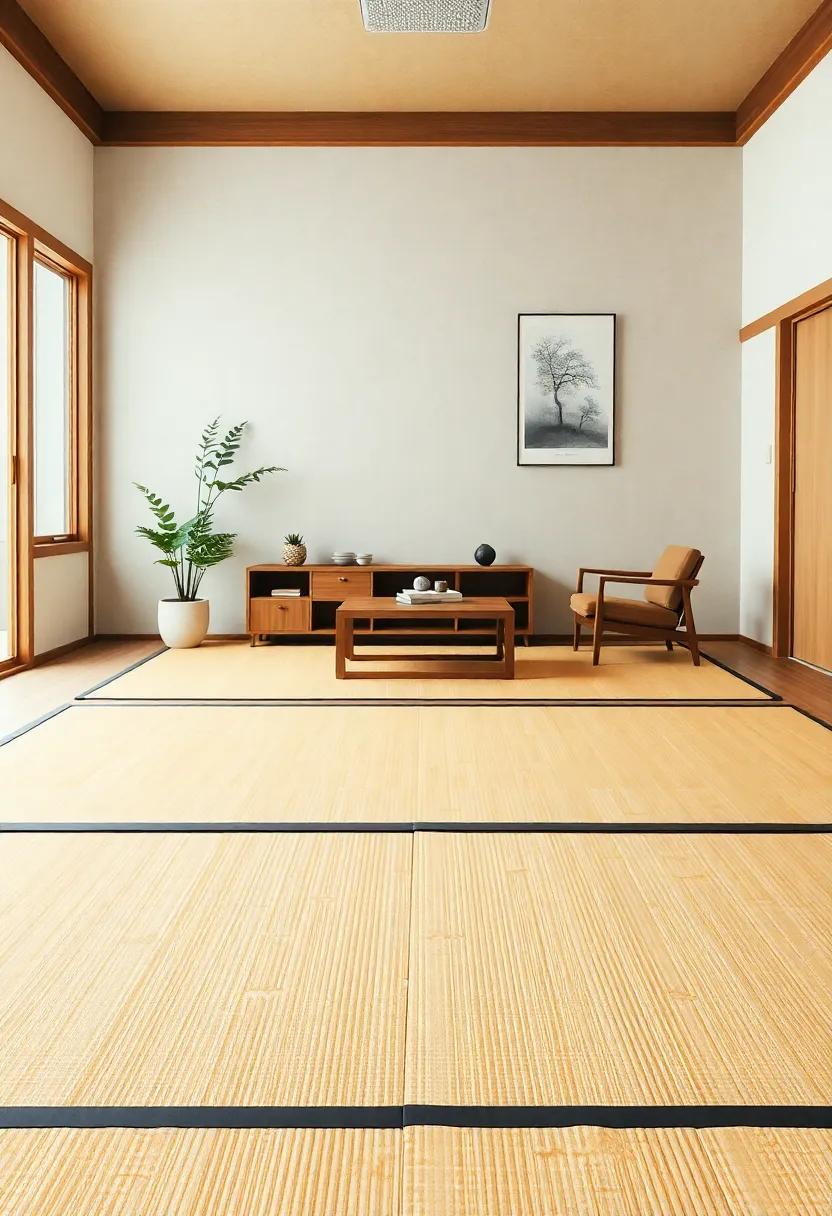
To truly appreciate the beauty and functionality of tatami mats, it’s essential to curate your bedroom layout thoughtfully. Begin by positioning your tatami mats centrally, allowing them to draw the eye as a statement feature. surround this natural flooring with low-profile furniture, such as platform beds or low tables, which will not only maintain the minimalist aesthetic but also enhance the open ambiance that tatami provides. Consider incorporating a few carefully selected elements: a simple shoji screen to expand your visual space, or a seating area with cushions that invites relaxation without cluttering the flow.
When arranging the furniture, keep the goal of harmony in mind. Use symmetrical arrangements for a calming effect or offset layouts to introduce warmth and intrigue. Incorporate natural materials like bamboo or light woods for furnishings to complement the earthy tones of the tatami.Choose decorative items sparingly,focusing on items like a small bonsai tree or a piece of Zen art that resonate with tranquility. To assist with your design vision, refer to the following table that outlines furniture pairings that evoke serenity in a tatami-inspired space:
| Furniture Type | Recommended Pairing |
|---|---|
| Platform Bed | Low nightstands |
| low Table | Cushioned seating |
| Shoji Screen | Minimalist artwork |
| Storage Boxes | Decorative baskets |
Balance Functionality with Aesthetics: Ensure every piece of furniture not only looks beautiful but also serves a purpose, maintaining the integrity of the tranquil design
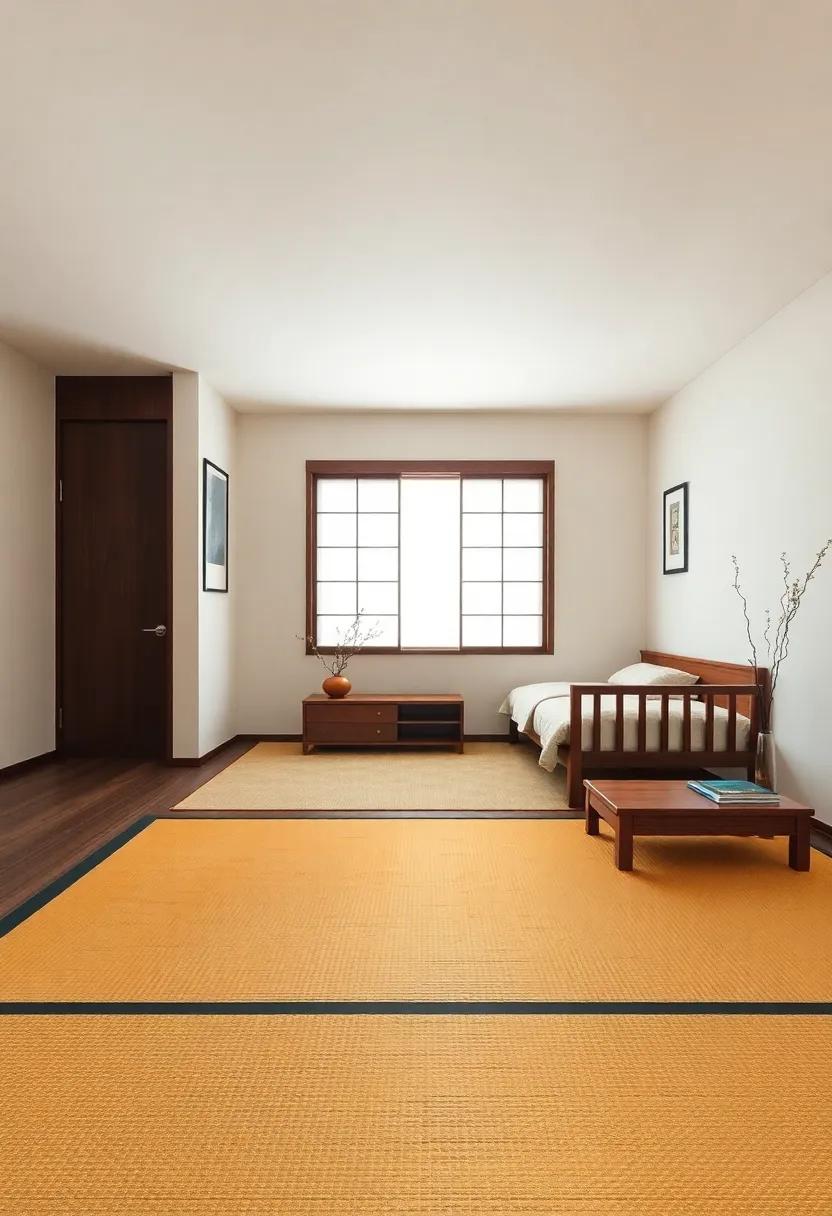
In a tranquil Japanese bedroom designed around tatami-style flooring,the furniture should embody both simplicity and functionality. Each piece can enhance the serene atmosphere while fulfilling everyday needs. As a notable example, consider a low-profile platform bed that seamlessly integrates into the space, promoting a sense of calm and grounding.A multipurpose tatami mat ottoman not only serves as a comfortable seat but also offers hidden storage for bedding or seasonal throw pillows,keeping the area tidy and clutter-free.
Moreover, integrating natural materials such as bamboo and wood can elevate aesthetic appeal while ensuring durability. A beautifully crafted wooden dresser with clean lines adds elegance and provides essential storage for clothing and linens. Light-filtering shoji screens can serve as a stylish room divider, enhancing privacy without sacrificing openness. Opting for décor that is both striking and purposeful ensures that every element contributes to the overall tranquility of the space.
Key Takeaways
As we conclude our journey through the serene world of Japanese-inspired bedroom design, we hope these 25 ideas have sparked your creativity and inspired you to create your own tranquil retreat. The harmonious marriage of tatami-style flooring, natural materials, and minimalist aesthetics invites you to slow down and breathe deeply, transforming your personal space into a soothing sanctuary.
Whether you choose to incorporate subtle shades of nature, experiment with layered textiles, or embrace the beauty of simplicity, remember that the essence of a Japanese bedroom lies in its ability to promote relaxation and mindfulness. so take a moment to reflect on what elements resonate with you and begin crafting a space that not only reflects your personal style but also nourishes your spirit.
May your new bedroom be a haven of peace, encouraging restful nights and rejuvenating mornings. Embrace the beauty of balance and let the tranquility of Japanese design inspire your everyday life. Happy decorating!
